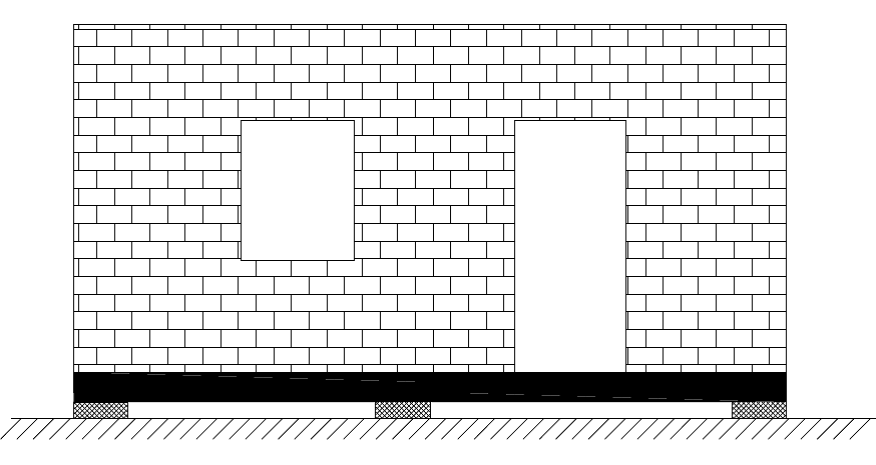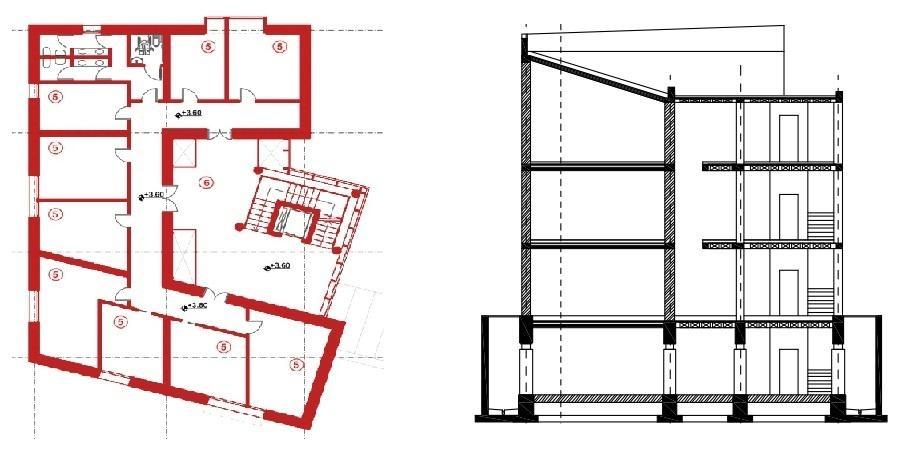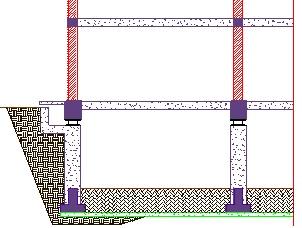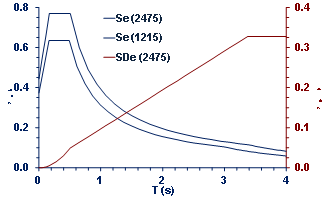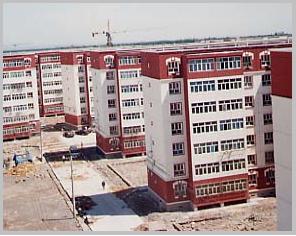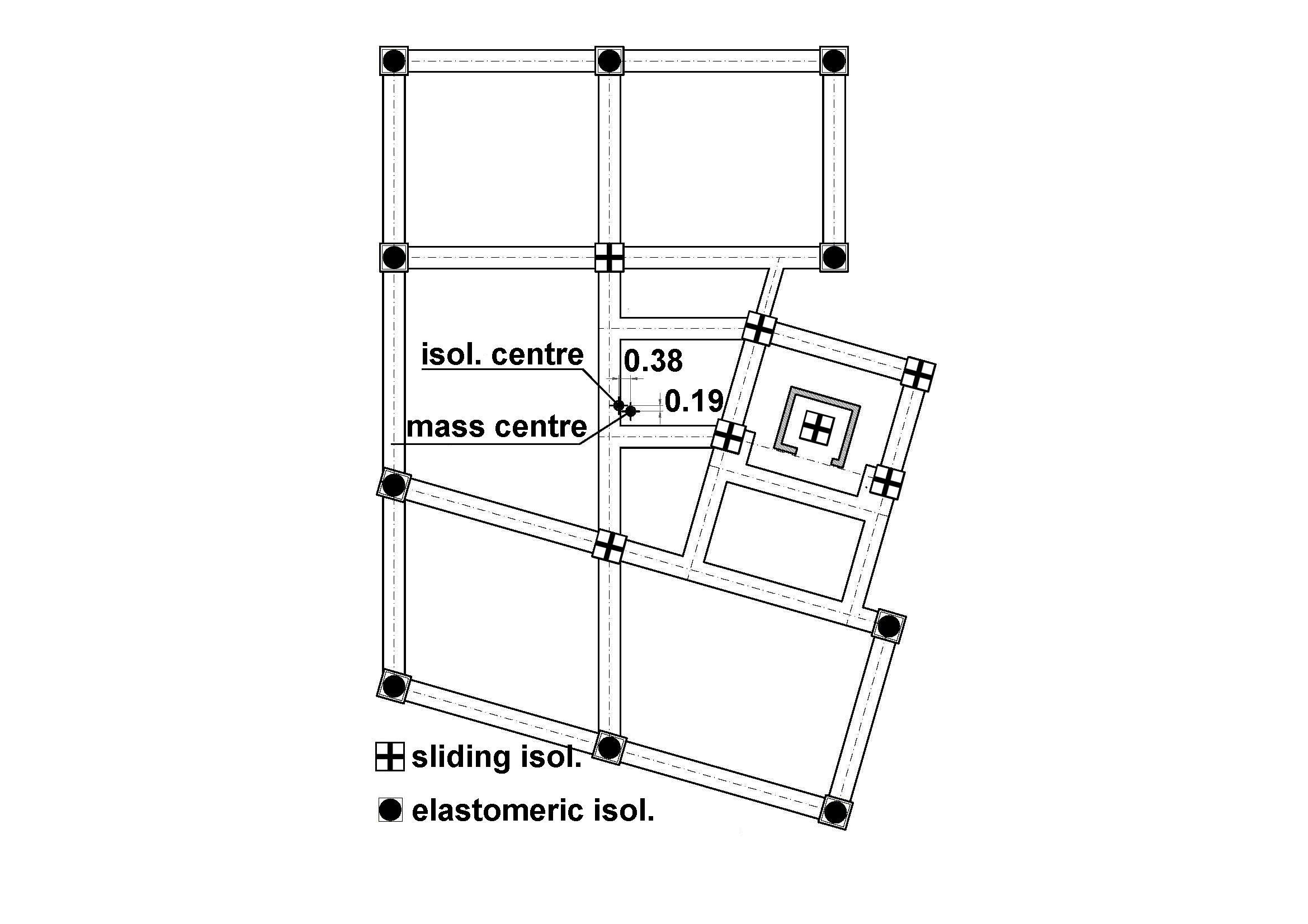Seismic isolation: the key to the revival of masonry in civil structures
Giacomo Buffarini, Paolo Clemente, Fernando Saitta - ENEA, Natural Risk Prevention and Effect Mitigation
DOI: 10.12910/EAI2013-37
The poor resistance to horizontal seismic actions of old masonry buildings, testified by catastrophic collapses after strong earthquakes, and the geometric restrictions enforced by technical codes discouraged from their application during last decades. On the other hand masonry, especially brick masonry, has a greater durability compared with other materials, as shown by many works of the past still existing nowadays. Thanks to the base isolation system, masonry structure has not to withstand significant seismic action, so that the architectural plan could have the freedom required to obtain better aesthetic results. Furthermore, brick masonry can guarantee optimal energy efficiency performance.
Technical codes prescribe rigid rules for masonry buildings, especially in seismic areas. Furthermore, the possibility of realizing simple buildings is highly encouraged and, consequently, the structural checks are very much simplified. Simple buildings are the ones that satisfy geometrical conditions in terms of:
- number of floors, usually not more than three,
- geometric regularity, ratio between the two horizontal sizes,
- wall length, thickness, slenderness, and distance between the parallel walls,
- size of the openings and their position.
As a matter of fact, masonry is certainly not very suitable in seismic areas, due to its low structural efficiency, particularly to its scarce tensile strength compared to its very high structural mass and low ductility. On the other hand, it should be noted that the most impressive collapses, occurred during heavy earthquakes, quite often affected very old buildings, made of irregular masonry with poor mortar. These were certainly not able to cope with horizontal seismic actions, even of low intensity. Noble buildings, with careful maintenance works during their life, showed a good structural behavior even under strong earthquakes (Bazzurro et al., 2009).
It is important to remind that buildings realized with traditional techniques suffer damage in case of high-intensity earthquakes and such damage will cause the energy transmitted by the soil to be dissipated. In the light of this, it follows that for earthquake-resistant structures, ductility is very important and certainly masonry is not the best solution.
It is evident that seismic isolation can be very useful for masonry buildings. As well known, it is based on the terrific reduction of the seismic actions affecting the structure, instead of relying on its resistance. This is pursued by increasing the natural period of the structure and, consequently, reducing the seismic action on the superstructure. Economic evaluations also demonstrated the suitability of seismic isolation, especially in high intensity hazard areas (Buffarini et al., 2007; Clemente and Buffarini, 2010; Satta et al., 2011).
It is also worth reminding that new brick masonry can guarantee a very long durability and a better performance in terms of energy efficiency, especially in cold climate, but also for refreshing during the summer. In the last few decades brick products have got a great evolution with improvements in quality and typologies, particularly for structural and energy performances, very important under extreme climate conditions.
In this paper the application of base isolation to masonry buildings is analysed, the structural solutions are presented, and then the project of a masonry building with a seismic base isolation system is shown.
Application of seismic isolation in masonry buildings
The use of seismic isolation in masonry buildings requires some preliminary considerations. Previous studies (Clemente et al., 2012) showed that, in order to optimize the building both from the economic and structural points of view, the number of isolation devices should be limited and they should be mainly deployed at the intersections of the bearing walls. As a result, a rigid structure under the walls of the first floor should be realized. This rigid structure is usually built in reinforced concrete and so the foundations, and should be able to transmit the static and dynamic actions from the superstructure to the isolation devices (Figure 1).
Moreover, since the inspection of the seismic isolation system must be allowed, it is advisable to realize an underground floor. Isolation devices could be placed at any height of the underground floor but, in this case, the structural elements between them and the upper deck must be very rigid in comparison with the devices themselves. It must be pointed out that, if isolators are at the base of the underground floor, in case of an earthquake the walls of this floor will have relative displacements with reference to the ground, the space around them resulting not usable. A gap is then needed to allow these relative displacements, which advisably requires that isolation devices be placed at the top of the basement level (Figure 2).
The cost-effectiveness of seismic isolated masonry buildings has also been demonstrated (Clemente et al., 2012). Actually, a large number of masonry buildings with seismic isolation, with a number of floors between 5 and 8, have been realized in Beijing (Figure 3) (Zhou et al., 2011).
In Italy, an isolated masonry building has been realized in Corciano (Parducci, 2009), consisting of two blocks of two and four levels respectively, with a reinforced masonry structure.
A case study
The architectural design
The above concepts were applied in the design of the service center for Sulmona municipality that will host local Police and registry offices open to the public and a convention hall of the administration. The building, in case of natural disaster, should also host the offices of Civil Protection and the main emergency activities in the town.
The building is C-shaped in plan, with a masonry structure and a central space with a glass wall. It will develop on four floors, three of them above the ground level, hosting the offices, while the underground floor could be used as a deposit or parking place. The usable surface for each floor is about 220 m2, while the area with the elevator and the stairway is about 50 m2 (Figure 4).
From the energetic point of view, the building is compliant with the current Italian standards and laws. In this way, the Near Zero Energy Building (NZEB) objective was achieved. Furthermore, all the materials used have a very low environmental impact, obtaining an eco-friendly structure.
The carrying structure is made of bricks with high energetic performance, with thermal isolation plaster, so as to obtain transmittance values 25% lower than those provided for by the current technical code. Special purpose-designed shielding bricks have been adopted to shield the glass openings of the central vertical element that contains the stairs and the elevator
Technological innovation and integrated design (seismic safety, energy efficiency and sustainability) allowed to obtain a building that can be considered an excellent prototype for future applications.
The energy efficiency study has been made using TRNSYS, a software system particularly reliable for the summer demand. The simulation, carried out taking into account the aeration and destination of the building, gives very interesting results, reaching a very high level of energy efficiency for the building (Buffarini et al. 2013).
The structure
The carrying structure of the three floors above the ground level are made of brick masonry blocks. Rectified blocks have been considered with thin horizontal joints (1 mm) and interlocking vertical joints with mortar pocket. External walls are 45 cm thick, with masonry tile for external finishing, while internal walls are 30 cm thick.
All the floors are made of concrete and bricks. The first deck above the isolators has been designed with very high stiffness beams, suitable to transmit the actions of the superstructure to the isolators, which have been concentrated at the wall crossings.
The thicknesses of the walls have been defined accounting for the energetic purposes and resulted abundant in the structural checks, the seismic effects being very low thanks to the isolation system. The superstructure is very stiff, with very thick walls placed at suitable distances and with rigid decks: that is very important for seismic isolation to be effective. The superstructure is separated from the substructure by the seismic isolation devices. The substructure, i. e. the foundation, is composed by orthogonal beams with large pillar (80x80 cm) needed to support the isolation devices (Figure 6).
The seismic actions
In agreement with the municipality, the building has been designed as strategic, able to host public offices in emergencies. The maximum return period TRSLC = 2475 years has been chosen for the check of the isolators (the so called collapse limit state, SLC). The use factor being CU = 2, the nominal life time is VN = 64 years. The corresponding return period relative to the checks of the superstructure and substructure is TRSLV = 1215 years (the so called life safeguard limit state, SLV). The damage limit state (SLD) has been considered for the superstructure only, by checking that the inter-story drifts during the design earthquake are less than 2/3 of the limit prescribed for a non-isolated building.
In Table 1, the values of the maximum horizontal acceleration g, of the maximum amplification factor0 and of the period T*c of the initial point of the constant velocity in the acceleration spectrum are summarized, for the site where the building will be realized and for the two limits states (SLC and SLV).
The subsoil can be assimilated to soil B type (deposits of very dense sand, gravel, or very stiff clay, at least several tens of meters in thickness, characterized by a gradual increase in the mechanical properties with depth). In the same Table 1, the parameters needed to define the spectral shape are reported: the subsoil coefficient S, the coefficient C, that modifies the value of the period T*c, and the other characteristic values of the period. The elastic response spectrum, usually plotted by using a 5% value of the damping, is scaled in the range T ≥ 0.8· Tis (Tis = natural period of the isolated structure), using the reduction factor η = 0.707, that corresponds to the equivalent viscous damping coefficient of the isolation system, assumed equal to ξ = 15%.
In Figure 5, the acceleration elastic response spectra for the mentioned return periods are plotted as well as the displacement response spectrum for the damping relative to the isolators (η = 0.707).
TABLE 1
Characteristic parameters of the elastic response spectra
|
Parameter |
PVR (%) |
TR (years) |
ag/g |
F0 |
TC* (s) |
S |
CC |
TB |
TC |
TD | |
|---|---|---|---|---|---|---|---|---|---|---|---|
|
SLV |
10 |
1215 |
0.352 |
2.40 |
0.365 |
1.06 |
1.35 |
0.16 |
0.49 |
0.51 |
|
|
SLC |
5 |
2475 |
0.443 |
2.46 |
0.380 |
1.00 |
1.33 |
0.17 |
3.01 |
3.37 |
Modeling and analysis
In order to define the seismic isolation system, the structure has been modeled as a rigid body constrained by linear springs along the two horizontal directions at the isolator locations.
The seismic isolation system consists of seven sliding isolators and ten elastomeric isolators having the horizontal stiffness Ke = 855 kN/m and able to support a maximum displacement dE=350 mm with a vertical load V = 2000 kN. They have been deployed as in Figure 6. The distribution of isolators has been chosen so to have the first two modal shapes with translation only, and therefore to minimize the torsional effects.
The fundamental period of the isolated building is Tis= 2.9 sec, that ensures the decoupling between the motion of the ground and the one of the superstructure, which without seismic isolation would have the first natural period of about 0.2 sec. The corresponding spectral values of acceleration and displacement for the collapse limit state are Se = 0.12 g and SDe = 0.31 m, respectively. The two horizontal components of the seismic action, also accounting for the casual eccentricity, have been added to the other actions according to the prescriptions of the Italian Technical Code.
The structural analysis has been carried out by means of a finite element model, which includes the substructure, the superstructure and the isolation system. Quad elements have been used for the masonry and the slabs, and beam elements for beams and columns. Slabs have different equivalent thicknesses for flexural and axial behavior and different elastic moduli in the two horizontal directions, in order to model the orthotropic behavior. The mass density of the slabs has been fixed so that all the dead loads are accounted for. The analysis showed that in the case of a fixed-base building the seismic response is influenced by higher modes, and confirmed that the model with seismic isolation has a regular behavior with the first two translational modes, with negligible rotational component and high modal mass participation.
Conclusions
Seismic isolation could be the key to the revival of masonry in civil structures, aiming at:
- a very high level of structural safety, so that also strategic buildings could be built with masonry, which should be operational also after strong earthquakes;
- a good architectural design, without the constrains due to the structural requirements typical of anti-seismic buildings, the seismic action that affects the superstructure being very low;
- optimal energetic performance thanks to masonry, reaching the objective of Near Zero Energy Building (NZEB) and using materials with a very low environmental impact.
The project of the Service Center in Sulmona, Italy, has been a good occasion to test the suitability of seismic isolation in masonry buildings.
Acknowledgements
The project of the Service Center in Sulmona has been realized within the framework of an agreement between ENEA, ANDIL (Italian association of brick manufacturers) and the municipality of Sulmona, Italy. The architectural design has been made by Paolo Luccioni, the structural design by Leopoldo Rossini, the energy aspects have been studied by Gaetano Fasano (ENEA).
References
Bazzurro P., Benedettini F., Clemente P., Martinelli A., Salvatori A. (2009). “Lezioni dal terremoto dell’Abruzzo: il comportamento degli edifici visto dall’angolo prospettico della regola d’arte nel costruire”. Energia, Ambiente e Innovazione, ENEA, Roma, No. 3, 28-45.
Buffarini G., Clemente P., Fasano G., Saitta F., G. Di Cesare, P. Luccioni, L. Rossini, De Deo M. (2013). "Edificio ENEA-ANDIL a Sulmona: struttura in muratura con isolamento sismico". Atti XIV Convegno Nazionale L’Ingegneria sismica in Italia, ANIDIS 2013 (Padova, 30 giugno - 4 luglio), N24.
Buffarini G., Clemente P., Satta A. (2007), Isolamento sismico: valutazioni economiche, Proc. of the XII Convegno Nazionale L’Ingegneria sismica in Italia, ANIDIS, Rome (in Italian).
Clemente P., Bontempi F., Boccamazzo A. (2012). "Base isolated masonry buildings". 15th World Conf. on Earth. Eng., 15WCEE, (Lisbon, 24-28 Sept.), Paper No. 3009.
Clemente P., Bontempi F, De Stefano A. (2012). "Application of seismic isolation in masonry buildings". Proc. 5th European Conference on Structural Control – EACS 2012 (Genoa, Italy, 18-20 June), Paper No. 117.
Clemente P., Buffarini G. (2010). Base isolation: design and optimization criteria. SIAPS 1:1,17-40, Mathematical Science Publisher.
Parducci A. (2010), La muratura isolata alla base come sistema costruttivo per le zone sismiche. Gli edifici sperimentali di Corciano (PG) ed altre esperienze, Esempi di Architettura Esempi di Architettura (EdA), IL PRATO, Saonara (PD) (in Italian)
Satta A., Buffarini G., Clemente P. (2011). “Aislamiento Sismico: Criterios de Disegño y Evaluaciones Economicas”. 4º Congreso Nacional de Ingeniería Sísmica (Granada, del 18 al 20 de Mayo 2011), No. 29.
Zhou F.L., Cui J., Tan P. and Wen L.H. (2011), Recent development and application on seismic isolation, energy dissipation and control in China. Proc., th World Conf. on Seismic Isolation, Energy Dissipation and Active Vibration Control of Structures, 12WCSI, Sept. 20-23, Sochi, Russia.


